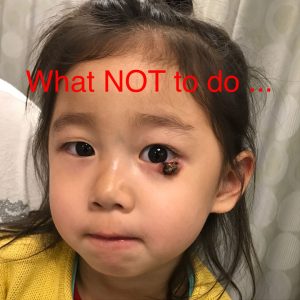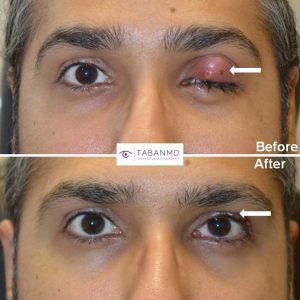Eyelid Chalazion (Stye)
What is a Chalazion?
An eyelid chalazion is simply a stye or growth along the eyelid that does not go away. While this might sound troubling at first, it generally is not a threat to your health. With the right eyelid surgeon, you can remove a chalazion quickly and safely. Dr. Taban has helped countless patients restore their appearance through various chalazion treatment options, each of which has been proven effective and safe.
What Causes Eyelid Chalazion?
It is due to a blocked tear gland in the eyelid. It occurs due to a common condition called blepharitis, which causes the many tiny tear glands in the eyelids to produce thick oily secretions. Styes are generally small in size and form as tiny but visible bumps on the inner or outer eyelid. Sometimes they also arise as a result of a bacterial infection. In short, it is a collection of thick mucus brought about by an inflammatory response.
What Symptoms Can This Cause?
Symptoms of blepharitis include ocular irritation, itching, foreign body sensation, and swelling. It can be mild to severe, and it can last days to many years. Accordingly, we recommend seeking treatment as soon as you begin to notice any symptoms. Not only can you get relief from your symptoms, but you can prevent the formation of styes in the first place.
A new stye can be painful, red, & swollen at first. However, these symptoms are usually temporary, lasting only hours to a few days. Fortunately, a stye usually goes away on its own without much problem. However, some styes don’t go away and result in a chalazion, which is painless. Still, they can be quite visible, which can affect your overall quality of life. With the right treatment, you can quickly restore your appearance to its former look.
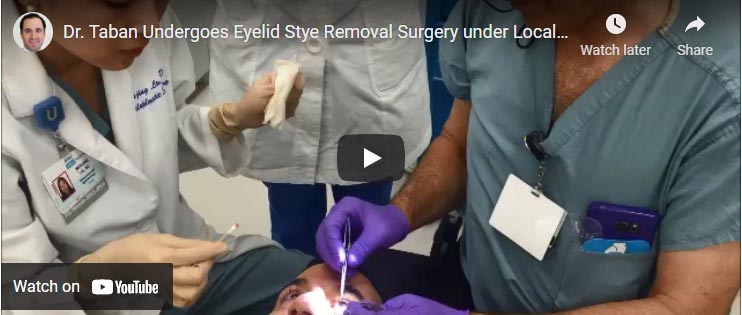
Treatment for Eyelid Styes
Most eyelid styes go away on their own within the first few hours to days. However, the longer they stay, the less chance they will go away. The size of the eyelid chalazion is also a factor. That is, the larger it is, the less chance it will go away on its own. They may get smaller but firmer and don’t go away. An injectable treatment can also complicate the outcome of the stye. So it is important to notify your oculoplastic surgeon about any previous cosmetic procedures before undergoing treatment for a stye.
A variety of treatments exist, including:
- Eyelid cleaning (baby shampoo scrubs, warm compresses)
- Oral medication (doxycycline)
- Ocular drops (Azasite and antibiotic/steroid combo drops)
- Aggressive eyelid hygiene
- Injection of specific medications (steroid, 5FU) into the chalazion
Surgical drainage
From time to time, surgical draining is required when the stye does not respond to medication or disappear on its own. However, the application of antibiotic eye drops usually results in their disappearance.
What Is Surgical Drainage?
If the eyelid chalazion is large or not going away, it is usually drained using a scarless technique. This method works from the inside of the eyelid while the patient is given local anesthesia, with or without oral sedation. There is typically a quick recovery. Sometimes, an external cut is required for growths with a significant external component. This might also work for styes that have already been drained internally but have a persistent outside component.
I (Dr. Taban) have had a stye that needed to be removed using the internal scar-less technique. You can watch the video of me undergoing this procedure myself on this page.
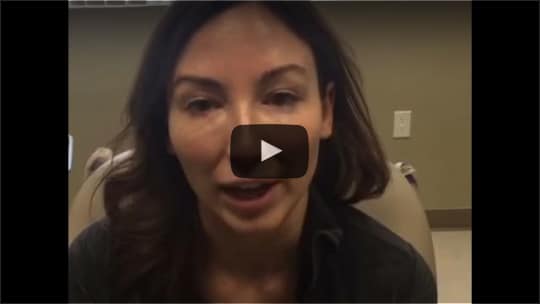
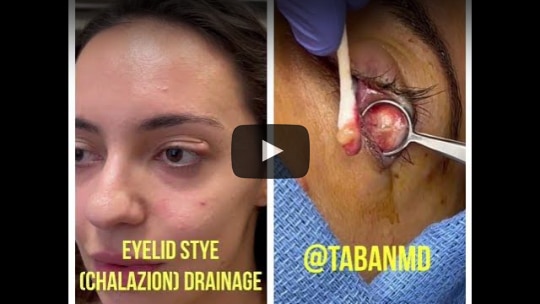
How To Prevent A Stye
As we mentioned, styes are most commonly caused by a bacterial infection such as blepharitis. As such, it’s always important to wash your hands before touching your own eyes or others. If you wear contacts, it’s especially important to practice a thorough hygiene routine whenever handling your lenses to eliminate germs and bacteria. If re-occurring eye fold styes seem to be a problem for you, you may want to consider visiting an expert ocular surgeon to correct this problem.
How Long Will a Chalazion Last?
A new eyelid stye can be painful, but that is usually temporary, lasting hours to days. A sty usually goes away on its own. However, some styes don’t go away and result in a chalazion, which is painless. It is a collection of thick mucus and inflammatory response. Treatment options depend on the size and exact location of the chalazion. Treatment options include aggressive eye fold hygiene, injection of a medicine into the chalazion, and surgical drainage. Dr. Taban uses a special combination of steroid and 5FU mixture to inject chalazions, which usually cause resolution of the chalazion in days to a few weeks without leaving any scars. Dr. Taban has contributed to many textbooks regarding the treatment and procedure process of eyelid chalazions.Schedule a Consultation Today
As one of the leading oculoplastic surgeons in the Los Angeles area, Dr. Taban can offer expert evaluation and a customized treatment plan. Each chalazion treatment plan includes every factor you need to address an unsightly or uncomfortable eyelid bump. Even non-surgical options may be all that is necessary to remove a stye.







